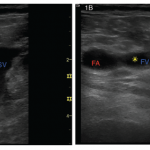The ancestral allele (clade A) dominates in Africa, whereas the same GROW1 mutation (clade B) can be found in Neandertals, Denisovans and modern Eurasians. This distribution raises the possibility of independent selection of ancestral standing variants. In the case of Eurasians, the allele is found near the center of a ~130-kb haplotype that runs from the GDF5 5’ untranslated region through the downstream region that controls limb length in mice. The resulting decreased bone growth, although increasing the risk for OA, may provide an associated selective advantage in mating, sexual selection, energetic control, thermoregulation or decreased risk of hip fracture.
Lara C. Pullen, PhD, is a medical writer based in the Chicago area.
ad goes here:advert-1
ADVERTISEMENT
SCROLL TO CONTINUE
Reference
- Capellini TD, Chen H, Cao J, et al. Ancient selection for derived alleles at a GDF5 enhancer influencing human growth and osteoarthritis risk. Nat Genet. 2017 Jul 3. doi: 10.1038/ng.3911. [Epub ahead of print]

